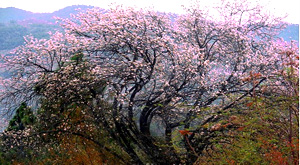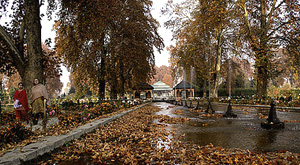SeasonsKashmir is the paradiseof India, known for an enchanting climate in all throughout the year. Itsrenowned climate can widely be categorized into four seasons as spring, summer,autumn, and winter. The climate of Kashmir can better be compared as that of Switzerland,until May. The valley is wrapped with emerald green grass and flowers of freshleaves- the utmost characteristics of climate of spring seasons. Blessed withabundant of scenic beauty, Jammu and Kashmir has tremendous potential in thetourism sector. The mesmerizing charm of Jammu and Kashmir attracts everyvisitor for an exciting holiday within the majestic locale.
A significantdistribution of seasons of Jammu and Kashmir: Spring - It comes alive inspring when nature bedecks the valley with blossom after blossom: almond, cherry,apple, peach, pears, pansies, narcissi, daises and many more. Throughout thevalley thousands of fruits and flowers burst into bloom exuding and alluringfragnance. Spring, which extends roughly from March to early May, is when a millionblossoms carpet the ground. The weather during this time can be gloriouslypleasant at 23oC or chilly and windy at 6oC. This is the season when Srinagarexperiences rains, but the showers are brief. Spring season sets in March and continues till early May. The weather thenis very pleasant and it would be no exaggeration to compare it with that ofSwitzerland. Kashmir raps itself in an emerald green jacket with flowerydesigns all over. The sight has a rich yet ethereal touch. Daisies cover theparks and gardens. The Climate of Jammu and Kashmir at this time of the year isideally suited to thoroughly enjoy the beauty of the place.
|  | Summer - Spring is followedby summer. Temperatures rise slightly. But the heat never reaches unendurablelimits. In comparison to other parts of the country particularly the plainregions, the Climate of Jammu and Kashmir is unbelievably lovely at this timeof the year as well. The rippling rivulets, the serene lakes, the chinargroves, the pine forests all appear very enticing in the summers. Fruits areripe and in plenty. Summer extends from May until the end of August. Light woollens may be required to wear out of Srinagar. In higher altitudes night temperatures drop slightly. Srinagar all this time experiences day temperature of between. 25oC and 35oC. At this time, the whole valley is a mosaic of varying shades of green - ice fields, meadows, trees, stc and Srinagar with its lakes and waterways is a heaven after the scorching heat of the Indian plains. |  |
Autumn - After summer, the most awaited seasonin Jammu and Kashmir sets in the month of September. It is autumn, the seasonof mists and mellow fruitfulness. Everything turns to gold. The sight of thelandscape has a magnetic appeal then. The red carpeted gardens are a treat tothe eyes. Temperatures rise to a maximum of 23 degrees in the morning but thenights are relatively colder. The weather is very conducive for the tourists totake delight in the sights, sounds and smell of this idyllic land. The vibrantvalleys, the rustle of the fallen leaves, the fragrance of flowers are there toenchant you.
The onset of autumn, perhaps Kashmir's loveliest season, is towardsSeptember, when green turns to gold and then to russet and red. The highest daytemperatures in September are around 23oC and night temperatures dip to 10oC byOctober, and further drop by November, when heavy woollens are essential. |  |
Winter - Winter in Jammu and Kashmir starts inthe month of December and it is extremely cold then. Even though the trees havea bare look and the beauty of the hued gardens no longer catches the eye, thereis an altogether different charm in the surroundings. The snow coveredlandscape is a visual treat as well. Through December, to the beginning of March is winter time, which presentsSrinagar in yet another mood. Bare, snow-covered landscapes being watched frombeside the warmth of a fire is a joy that cannot be described to anyone who hasnot experienced it. Some houseboats and hotels remain open in winter-these areeither centrally heated or heated with ‘bukharis', a typically Kashmiri stovekept alight with embers of wood, quite effective in the winter.
|  |
|
|